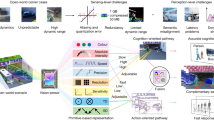Abstract
The purpose of this chapter is to describe how different visual routines can be developed and embedded in the AnaFocus’ Eye-RIS Vision System on Chip (VSoC) to close the perception to action loop within the roving robots developed for the testing of the insect brain models. The Eye-RIS VSoC employs a bio-inspired architecture where image acquisition and processing are intermingled and the processing itself is carried out in two steps. At the first step, processing is fully parallel owing to the concourse of dedicated circuit structures which are integrated close to the sensors. At the second step, processing is realized on digitally-coded information data by means of digital processors. The Eye-RIS VSoC systems provide with image-processing capabilities and speed comparable to high-end conventional vision systems without the need for high-density image memory and intensive digital processing. Current perceptual schemes are often based on information derived from visual routines. Since real world images are quite complex to be processed for perceptual needs with traditional approaches, more computationally feasible algorithms are required to extract the desired features from the scene in real time, to efficiently proceed with the consequent action. In this chapter the development of such algorithms and their implementation taking full advantage of the sensing-processing capabilities of the Eye-RIS VSoC are described.
Access this chapter
Tax calculation will be finalised at checkout
Purchases are for personal use only
Similar content being viewed by others
References
P. Arena, S. De Fiore, L. Patané, P.S. Termini, R. Strauss. Visual learning in drosophila: application on a roving robot and comparisons, in 5th SPIE’s International Symposium on Microtechnologies, pp. 1–12
P. Arena, S. De Fiore, L. Fortuna, L. Nicolosi, L. Patané, G. Vagliasindi, Visual homing: experimental results on an autonomous robot, in 18th European Conference on Circuit Theory and Design (ECCTD 07).
P. Arena, L. Patané, P.S. Termini, Decision making processes in the fruit fly: a computational model, in Frontiers in Artificial Intelligence and Applications - Proceedings of the 21st Italian Workshop on Neural Nets, vol. 234
P. Arena, M. Cosentino, L. Patané, A. Vitanza, Sparkrs4cs: a software/hardware framework for cognitive architectures, in 5th SPIE’s International Symposium on Microtechnologies, pp. 1–12
P. Arena, L. Patané, P.S. Termini, A. Vitanza, R. Strauss, Software/hardware issues in modelling insect brain architecture, in 4th International Conference on Intelligent Robotics and Applications (ICIRA)
S. Battiato, A. Castorina, M. Mancuso, High dynamic range imaging for digital still camera: an overview. J. Electron. Imaging 12/3, 459–469 (2003)
A. el Gamal. High dynamic range image sensors. Tutorial ISSCC’02, 2002
M. Mronz, B. Poeck, K. Neuser, T. Triphan, R. Strauss, Analysis of a spatial orientation memory in drosophila. Nature 453, 1244–1247 (2008)
P. Arena, S. De Fiore, L. Patané, L. Alba, R. Strauss, Drosophila-inspired visual orientation model on the eye-ris platform: experiments on a roving robot, in Proceedings of the SPIE Microthecnologies Conference, Prague
A.K. Mishra, Y. Aloimonos, Active segmentation. Int. J. Humanoid Rob. 6/3, 361–386 (2009)
L. Alba, P. Arena, S. De Fiore, L. Patane, R. Strauss, G. Vagliasindi. Implementation of a drosophila-inspired model on the eye-ris platform, in Proceedings of the IEEE International Conference of CNNA, Berkley
W.T. Freeman, D. Anderson, P. Beardsley, C. Dodge, H. Kagez, K. Kyumaz, Y. Miyakez, M. Roth, K. Tanakaz, C. Weissman, W. Yerazunis, Computer vision for interactive computer graphics. IEEE Comput. Graphics Appl. 42–53 (1998)
D. Proffitt, T. Banton, Perceived depth is enhanced with parallax scanning. University of Virginia - Cognitive Science Department, March, Technical report, 1999
T. Lindeberg, Edge detection and ridge detection with automatic scale selection. Technical report, Computational Vision and Active Perception Laboratory (CVAP) Department of Numerical Analysis and Computing Science KTH (Royal Institute of Technology), August, 1998
R.C. Gonzalez, R.E. Woods, Digital Image Processing (Addison-Wesley Publishing Company Inc., Reading, 1992)
P. Nordlund, Figure-ground segmentation using multiple cues. Technical report, Computational Vision and Active Perception Laboratory (CVAP) Department of Numerical Analysis and Computing Science KTH (Royal Institute of Technology), May , 1998
E. Alegre, R. Alaiz-Rodrguez, J. Barreiro, J. Ruiza, Use of contour signatures and classification methods to optimize the tool life in metal machining. Est. J. Eng. 15–1, 312 (2009)
T. Fober, H. Hullermeier, Similarity measures for protein structures based on fuzzy histogram comparison, in Proceedings World Congress on Computational Intelligente (2010)
D. Dusha, W. Boles, R. Walker, Fixed-wing attitude estimation using computer vision based horizon detection, in Proceedings 12th Australian International Aerospace Congress, pp. 1–19 (2007)
B. Zafarifar, H. Weda, P.H.N. de With, Horizon detection based on sky-color and edge features, in Visual Communications and Image Processing (VCIP), vol. 682220, pp. 1–9 (2008)
T. Cornall, G. Egan, Calculating attitude from horizon vision, in Proceedings AIAC-11 Eleventh Australian International Aerospace Congress, pp. 1–8 (2011)
P. Arena, S. De Fiore, L. Patané, M. Pollino, C. Ventura, Insect inspired unsupervised learning for tactic and phobic behavior enhancement in a hybrid robot, in WCCI 2010 IEEE World Congress on, Computational Intelligence, pp. 2417–2424
P. Arena, L. Patané, M. Pollino, C. Ventura, Tribot: a hybrid robot for cognitive algorithm implementation, in 18th IEEE Workshop on Nonlinear Dynamics of Electronic Systems (NDES 2010), pp. 1–6
Author information
Authors and Affiliations
Corresponding author
Editor information
Editors and Affiliations
Rights and permissions
Copyright information
© 2014 Springer International Publishing Switzerland
About this chapter
Cite this chapter
Caballero-Garcia, D.J., Jimenez-Marrufo, A. (2014). Visual Routines for Cognitive Systems on the Eye-RIS Platform. In: Arena, P., Patanè, L. (eds) Spatial Temporal Patterns for Action-Oriented Perception in Roving Robots II. Cognitive Systems Monographs, vol 21. Springer, Cham. https://doi.org/10.1007/978-3-319-02362-5_9
Download citation
DOI: https://doi.org/10.1007/978-3-319-02362-5_9
Published:
Publisher Name: Springer, Cham
Print ISBN: 978-3-319-02361-8
Online ISBN: 978-3-319-02362-5
eBook Packages: EngineeringEngineering (R0)




